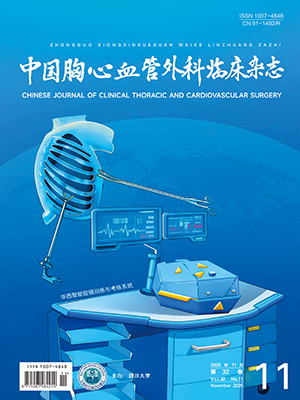| 1. |
蔣子薇, 趙海波, 劉溢思. 心臟術后纖維蛋白原和膠原代謝的變化規律及其與術后心房顫動關系的前瞻性隊列研究. 中國胸心血管外科臨床雜志, 2022, 29(3): 335-345.Jiang ZW, Zhao HB, Liu YS. Changes of fibrinogen and collagen metabolism after cardiac surgery and their relationship with postoperative atrial fibrillation: A prospective cohort study. Chin J Clin Thorac Cardiovasc Surg, 2022, 29(3): 335-345.
|
| 2. |
Liu Y, Wu F, Wu Y, et al. Mechanism of IL-6-related spontaneous atrial fibrillation after coronary artery grafting surgery: IL-6 knockout mouse study and human observation. Transl Res, 2021, 233: 16-31.
|
| 3. |
Hindricks G , Potpara T , Dagres N , et al. 2020 ESC guidelines for the diagnosis and management of atrial fibrillation developed in collaboration with the European Association of Cardio-Thoracic Surgery (EACTS). Eur Heart J, 2021, 42(5): 373-498.
|
| 4. |
January CT , Wann LS , Calkins H , et al. 2019 AHA/ACC/HRS focused update of the 2014 AHA/ACC/HRS guideline for the management of patients with atrial fibrillation. Circulation, 2019, 140(2): e125-e151.
|
| 5. |
國家心血管病中心. 冠狀動脈旁路移植術后心臟康復專家共識. 中國循環雜志, 2022, 35(1): 4-15.National Center for Cardiovascular Disease. Expert consensus on cardiac rehabilitation after coronary artery bypass grafting. Chin Circ J, 2022, 35(1): 4-15.
|
| 6. |
Frendl G , Sodickson AC , Chung MK , et al. 2014 AATS guidelines for the prevention and management of perioperative atrial fibrillation and flutter for thoracic surgical procedures. J Thorac Cardiovasc Surg, 2014, 148(3): e153-e193.
|
| 7. |
Muehlschlegel JD, Burrage PS, Ngai JY, et al. Society of Cardiovascular Anesthesiologists/European Association of Cardiothoracic Anaesthetists practice advisory for the management of perioperative atrial fibrillation in patients undergoing cardiac surgery. Anesth Analg, 2019, 128(1): 33-42.
|
| 8. |
中國冠狀動脈旁路移植術后二級預防專家共識組, 中國醫師協會心血管醫師分會冠心病外科學組, 中華醫學會胸心血管外科學分會冠心病外科學組. 中國冠狀動脈旁路移植術后二級預防專家共識(2020版). 中華胸心血管外科雜志, 2021, 37(4): 193-201.Working Group of the Chinese Expert Consensus on Secondary Prevention after Coronary Artery Bypass Surgery, The Task Force for Coronary Artery Disease of Chinese Association of Cardiovascular Surgeons(CACS), The Task Force for Coronary Artery Disease of Chinese Society of Thoracic and Cardiovascular Surgery(CSTCVS). Chinese expert consensus on secondary prevention after coronary artery bypass surgery (2020). Chin J Thorac Cardiovasc Surg, 2021, 37(4): 193-201.
|
| 9. |
李維瑜, 劉靜, 余桂林, 等. 知信行理論模式在護理工作中的應用現狀與展望. 護理學雜志, 2015, 30(6): 107-110.Li WY, Liu J, Yu GL, et al. Application of the knowledge-belief-practice model in nursing practice: Current status and prospeets. J Nurs Sci, 2015, 30(6): 107-110.
|
| 10. |
花文哲, 劉珊珊, 朱大喬. 理論域框架的發展及其應用進展. 護理研究: 下旬版, 2016, 30(6): 3.Hua WZ, Liu SS, Zhu DQ. Development and application progress on theoretical domains framework. Chin Nurs Res, 2016, 30(6): 3.
|
| 11. |
Chen SY, Yen WJ, Lin YJ, et al. A Chinese version of the Caring Assessment Report Evaluation Q-sort scale for measuring patients' perception on nurses' caring behaviours: Reliability and validity assessment. Inter Jf Nurs Prac, 2012, 18(4): 388-395.
|
| 12. |
Ferguson C, Inglis SC, Newton PJ, et al. Education and practice gaps on atrial fibrillation and anticoagulation: A survey of cardiovascular nurses. BMC Medical Education, 2016, 16(9): 1-10.
|
| 13. |
Chang SS, Dong JZ, Ma CS, et al. Current status and time trends of oral anticoagulation use among chinese patients with nonvalvular atrial fibrillation: The Chinese Atrial Fibrillation Registry Study. Stroke, 2016, 47(7): 1803-1810.
|
| 14. |
張亮, 周捷波, 呂瑩, 等. 基于健康信念模型的醫務人員職業暴露預防行為的調查研究. 華西醫學, 2023, 38(3): 392-397.Zhang L, Zhou JB, Lv Y, et al. Investigation on preventive behaviors of occupational exposure in medical staff based on health belief model. West China Med J, 2023, 38(3): 392-397.
|
| 15. |
葉雅雯, 王麗姿. 護士參與心房顫動患者抗凝管理模式的研究現狀. 中國實用護理雜志, 2017, 33(15): 5.Ye YW, Wang LZ. Nurses' participation in the management of anticoagulation among patients with atrial fibrillation: A literature review. Chin J Prac Nurs, 2017, 33(15): 5.
|
| 16. |
Valente TW, Paredes P, Poppe PR. Matching the message to the process the relative ordering of knowledge, attitudes, and practices in behavior change research. Hum Commun Res, 1998, 24(3): 366-385.
|
| 17. |
陳耀龍, 史乾靈, 趙俊強, 等. 從知到行: 跨越指南理論與實踐的鴻溝. 協和醫學雜志, 2020, 11(6): 746-753.Chen YL, Shi QL, Zhao JQ, et al. From knowledge to action: Bridging the gap between theory and practice in clinical practice guidelines. Med J Peking Union Med Coll Hosp, 2020, 11(6): 746-753.
|
| 18. |
Pronovost PJ. Enhancing physicians' use of clinical guidelines. JAMA, 2013, 310(23): 2501-2502.
|
| 19. |
晏蓉, 李素云, 劉云訪. 210名外科護士循證護理能力現狀及影響因素分析. 護理學報, 2019, 26(6): 47-50.Yan R, Li SY, Liu YF. Evidence-based nursing ability of surgical nurses and its influence factors: A 210-case study. J Nurs, 2019, 26(6): 47-50.
|
| 20. |
馬艷秋, 沈悅好, 武蕊, 等. 基于理論域框架的ICU護士執行身體約束縮減行動障礙因素的質性研究. 天津護理, 2022, 30(6): 5.Ma YQ, Shen YH, Wu R, et al. Barriers of ICU nurses perform physical restraint minimization actions:a qualitative study based on theoretical domains framework. Tianjin J Nurs, 2022, 30(6): 5.
|
| 21. |
Nilsson K, Brulin C, Grankvist K, et al. Senior nursing students' reflections on deviations from guideline adherence regarding venous blood specimen collection practice: A qualitative study. Nurse Educ Today, 2022, 115: 105375.
|
| 22. |
張靜, 梁士楚, 陳忠蘭. 護理領域中臨床實踐指南依從性的研究進展. 中華護理雜志, 2023, 58(6): 758-763.Zhang J, Liang SC, Chen ZL. The adherence of clinical practice guidelines in nursing fields: Where things stand. Chin J Nurs, 2023, 58(6): 758-763.
|
| 23. |
楊莉, 葉紅芳, 孫倩倩. 臨床護士循證護理能力現狀及影響因素分析. 護士進修雜志, 2023, 38(2): 108-113.Yang L, Ye HF, Sun QQ. Current status of evidence-based nursing ability in clinical nurses and its influencing factors. J Nurs Train, 2023, 38(2): 108-113.
|
| 24. |
周穎, 王加謀, 田曉勤, 等. 護士職業認同的研究進展. 鄂州大學學報, 2022, 29(4): 109-112.Zhou Y, Wang JM, Tian XQ, et al. Research progress on nurses' professional identity. J Ezhou Univ, 2022, 29(4): 109-112.
|
| 25. |
喻佳潔, 李琰, 陳雯雯, 等. 從循證醫學到循證科學的必然趨勢. 中國循證醫學雜志, 2019, 19(1): 119-124.Yu JJ, Li Y, Chen WW, et al. The inevitable tendency from evidence-based medicine to evidence-based science. Chin J Evidence-Based Med, 2019, 19(1): 119-124.
|




